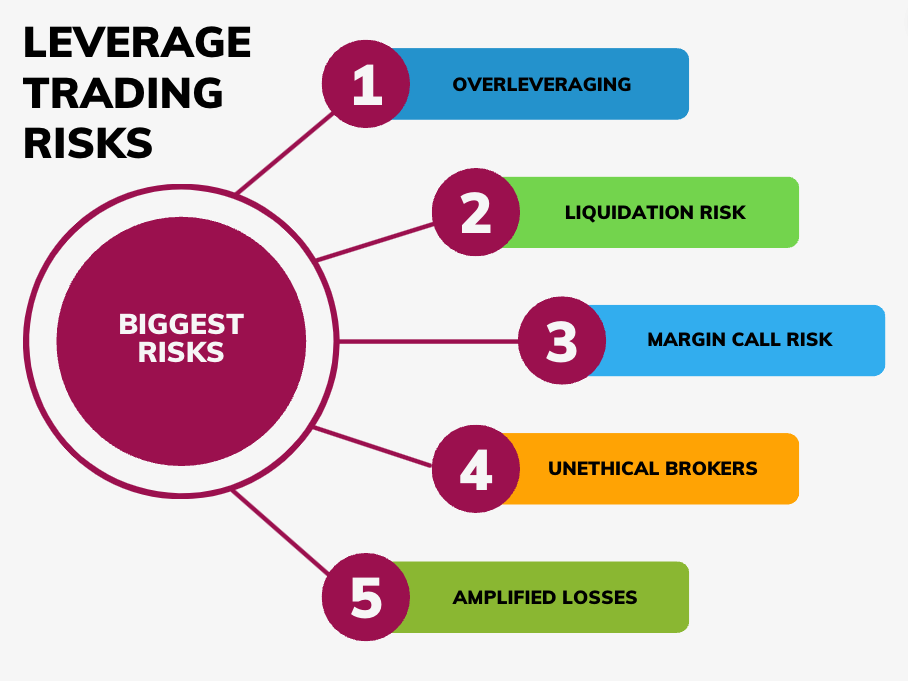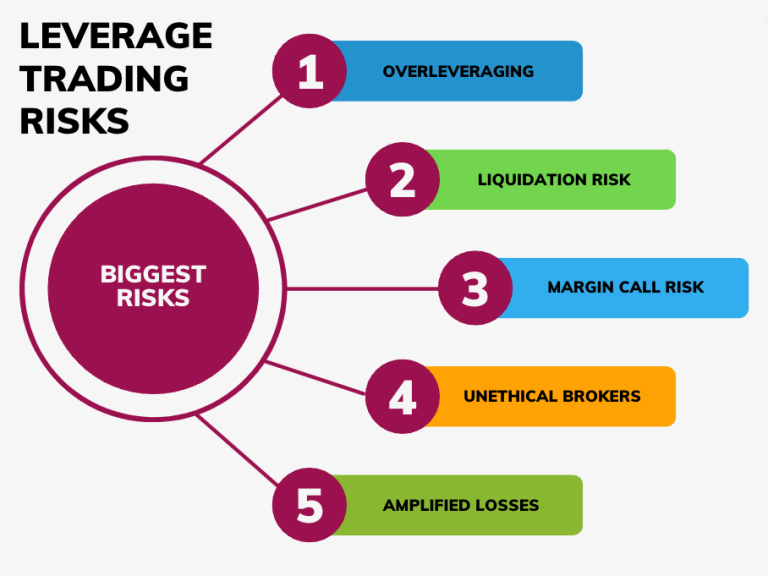The main risks of leverage trading tend to be the misuse of borrowed capital by the individual trader which is ultimately what causes most of the dangers for beginners.
However, there are more dangers of trading with a margin that beginners need to be aware of to avoid simple mistakes.
Everything from shady brokers to increased fees, and how your strategies might now work the same way in a more volatile market.
This is where things usually go wrong when traders use too much capital in a volatile market.
Key takeaways
- The amplified risk of loss is the main risk of leverage trading that causes dangers for beginners and uneducated investors.
- Misuse of margin, high volatility, overleveraging, margin call risks, lack of regulation, and liquidation risks are some other common risks of leverage trading.
- Avoiding these risks can be achieved by trading with a low ratio, understanding market volatility, and using a stop-loss order.
Content table
- Dangers of trading with leverage
- Common risks
- How leverage trading can increase risk
- Example of how leverage can increase risk
- Comparison of risks without margin
- High cost of borrowing money
- Steps to mitigate these trading risks
- FAQ
- Conclusion
What are the dangers of trading with leverage?


The disadvantages of trading with leverage are usually overleveraging, high commission costs, outsized losses, and the use of unethical trading platforms.
All of these factors are essentially dangerous for beginners since they are not visible and most novice traders fall into the trap of using too much debt.
Since credit acts as a multiplier, traders will experience more of whatever their result is, wins or losses.
This also boils down to what market you trade.
Some markets are very forgiving with the use of debt while others, like cryptocurrencies, can be a rollercoaster ride due to the volatility.
Margin risks and risks of liquidation are the biggest threat to a trader and should be avoided at all times since they are a direct danger to the trading capital.
Common risks of leverage trading
When thinking of the most common risks of leverage trading, these are the things that traders should watch out for.
I have listed them in no particular order, however, anything that is directly connected to your account capital is inherently more risky.
Some of these risk factors will not affect you.
For example, if you are trading forex with debt, volatility will not be a big problem since the average volatility of currency pairs is very low compared to other leverage products.
I recommend calculating forex risk to take full control over how much you want to risk per trade and to choose the correct position size per trade.
High Volatility
High market volatility is a problem for traders who are using a high margin because it further amplifies the potential losses of each trade.
It’s not as much of a problem when trading with a ratio of 2x leverage, however, when you get up to ratios of 100x leverage, then you will start to feel the effect.
Anyone who is doing crypto trading can sign off on this because that’s where the real volatility exists.
High volatility plus high debt will cause your positions to swing from highly profitable to big losers in a matter of seconds if you are not careful.
Overleveraging
A very common risk is overleveraging and this usually happens for beginners who don’t know how leverage trading works.
As tempting as it might be, more money doesn’t necessarily mean more profit.
When traders first find that they can borrow money to increase their position size and potentially their profit, many go crazy and use too much capital.
The result of this tends to be a couple of early lucky wins if the market is trending in the right direction followed by a series of large losses.
This happens because novice traders don’t account for the risks and there are no proper risk management strategies in place.
Instead of using a ratio of 50x or 75x, lower it to a ratio of a maximum of a 10x multiplier to stay on the safe side.
Use a leverage calculator to see what ratio works best for you.
Margin call risks
The margin call is a factor that only affects accounts where there is a margin requirement apparent.
This means that the portion of the trade size that is made up of the trader’s money is at risk.
Since your account balance acts as risk capital, the margin call will cause problems when you either use too much debt or when your positions turn into a big loss.
The way that margin trading losses are distributed is that the trader will always be responsible for all the losses.
The broker only provides the leverage but all the profits and losses are added or deducted to the account balance.
Should the account balance get in danger, the broker will send out a margin call.
Lack of regulation
This is not a direct risk to your account and your trading capital but in the world of high-paced trading, many platforms that operate with leverage are not honest.
There have been many cases where traders have lost more money than they invested through leverage.
This can in some cases cause you to go into debt with your broker.
That’s why we always recommend using regulated forex brokers or a broker with negative balance protection.
Simply choosing one of the mainstream CFD trading platforms or spread betting brokers will remove these risks.
Liquidation risks
A general rule for traders who are using borrowed money is to do everything they can to stay away from getting liquidated.
What many traders don’t know is that the liquidation tool is a tool for brokers to save their skin.
Why is this you may ask?
The thing that brokers are trying to avoid is taking the risk of any position.
This makes sense because if they would take the risk of every trade they would go out of business immediately.
Instead, if a trader loses more money than they have deposited, they automatically close out the trade.
Trust me, this is a good feature and most brokers should apply this rule.
Getting liquidated is a better option than owing thousands of dollars to the broker should they not stop the trade out when it went against you.
However, staying away from the risk of liquidation is the most important job for a trader which can be achieved by using the right high leverage trading plans.
Overtrading
Overtrading is when a trader gets carried away by the joy of trading the markets without considering the risks ahead.
A clear signal of overtrading is when a trader is opening trade after trade where most of the positions end up as losers.
Even though, the trader doesn’t stop trading, hence the word overtrading.
Overtrading is a huge risk since all the losses will be amplified due to the increased buying power.
Instead of losing a few dollars here and there, the losses can quickly amount to hundreds of dollars.
This is why you always have to select leverage for a beginner with a small account before entering the market.
That way overtrading will not hurt you that much.
If you realize that your trading gets out of hand and your losses start building up, take a break and come back later.
It is also a good idea to start over with a low ratio such as 1:2 leverage to start again at a slow pace.
Overtrading is also expensive considering that margin trading commission are increased by the ratio chosen.
How leverage trading can increase risk
In the same way that leverage increases profits, it also increases the potential for losses due to larger trade sizes.
Once again it is the ratio that determines how much a position will lose once it goes against you.
Using a high ratio means that the loss will be more amplified while using a lower ratio means a less significant loss.
The added risk factor to a leveraged trade is the margin call and the risk for liquidation.
These risks will affect your whole account as well as the margin requirement which is the funds required by the broker to open a position.
Depending if you are leveraging using isolated or cross margin the risk might only affect the margin requirement itself of the whole account.
Isolated margin risks only affect the margin requirement for one single position while cross margin risks will affect the whole account.
Example of how leverage trading increases risk
Once a trade goes against the trader the amount of debt will decide how big the loss will get.
A position size of $200 will lose less money compared to a position size of $2000.
Since the position size worth $2000 is 10 times larger, it will naturally lose 10 times more money.
A loss of 10% on $200 without credit is a loss of $20 while a loss of 10% on a $2000 trade is worth $200.
To get a more in-depth understanding read our guide on how leverage affects losses.
Comparison of risk with and without leverage trading
First of all, traders do not run the risk of liquidation if they use 1x leverage, or in other words when trading without borrowed capital.
This is the main difference when looking at the big risk factors.
Then we have the risk of the actual losses that are going to be much larger when you trade with increased buying power.
The fees are also another big factor as mentioned in the previous section.
Without noticing, traders can easily spend hundreds of dollars in collective fees in a day.
Overall, traders who do not use borrowed money are less likely to lose large sums of money but on the other hand, they are also less likely to make big gains.
This is something that each trader has to think of.
High cost of borrowing money
It indeed costs more money to trade with borrowed money and the way it works is rather subtle.
First, you have the transaction costs that increase according to your position size.
Then you have the overnight management fee that comes in for traders who decide to keep positions open until the next day.
These costs can amount to $10, 20, and even up to $50 depending on how much money you have borrowed.
As you see, there is no applied fee for using the leverage.
Instead, everything you do with the borrowed money simply costs more since you are controlling a larger sum of money.
Therefore, to avoid these costs, leverage for forex is usually a 1:200 multiplier or lower.
Steps to mitigate leverage trading risks
Managing risks is crucial for long-term success in highly volatile markets.
Below are some strategies to help you mitigate some of the risks:
Risk management strategies
Identifying the potential risks in your market and in the way you trade is the core of your risk management strategy.
For this, you can use technical analysis and three effective calculators:
These calculators will help you choose the risk size for your position, find the correct risk reward ratio for your setup, and control that your liquidation price is out of reach from market volatility.
One simple but very effective way of managing your risk is to diversify your portfolio over several different assets.
By using these techniques, your trading risks will be reduced significantly.
Setting up stop-loss orders
A stop-loss is a trading tool that automatically stops your position at a certain price below your entry price.
It is a controlled way of taking losses and professional traders use them all the time.
Our stop loss calculator can help you set the perfect stop loss based on your entry price and the amount of risk you want to take on in percentage.
Let’s say that you want to trade META stock and it is currently trading at $240.
You can choose to add a stop-loss $10 below the entry price.
This means that if the price starts falling, your position will automatically be stopped out at $230, preventing further losses.
Investopedia says that “One key advantage of using a stop-loss order is you don’t need to monitor your holdings daily”.
This is true because even if you leave your position open overnight, the stop-loss order will cancel your position in the case of a market fall.
Avoiding over-leverage
A common mistake by beginners is to over-leverage and the result is usually a blown-up account.
Your job as a trader is to always preserve your capital and this is where the trading risk is most problematic.
Choose a ratio that you feel comfortable with.
Start low and work from there.
For example, a standard leverage ratio for crypto traders is between 10x and 99x.
The reason that there is such a big gap between the top and the bottom depends on each trader.
If you can avoid over-leveraging you will be one step closer to achieving success.
Understanding market volatility
High market volatility and debt trading can be a one-way ticket to losing your capital.
You need to study market volatility and understand when it is safe to borrow more money and when you should stay out of the market.
When the market acts irrationally, it is usually a better idea to take a break and come back later.
The best time to enter the market is just before a breakout.
A breakout is an event that happens after the market has slowed down and is ready to move to the next price level.
Just before a breakout, there will be a moment of lower volatility and this is the best time to enter according to many professionals.
Choosing a reliable broker
The last and usually the least dangerous trading risk is which type of broker you should choose.
Depending on what products you want to trade there are many different options to choose between.
If you are looking to trade spread betting leverage, your best option is of course one of the best spread betting brokers that are regulated.
If you want to trade Bitcoin, choose one of the platforms in our us crypto exchanges with leverage list.
No matter what type of broker you choose, the most important factor is that it is regulated by a government agency such as the FCA, FinCEN, or CySEC.
Once you have found a couple of regulated platforms, it is time to start looking at the technical specifications, and the fees table.
It’s wise to prioritize low trading fee brokers because your positions will be larger and it can quickly get costly if your platform doesn’t offer low transaction costs.
FAQ
Safety always comes down to how much leverage you are comfortable trading with. Many beginners are better off using a ratio that is lower than 1:10.
The risks associated with margin trading can be overwhelming for a complete beginner and therefore it might be wise to practice without debt until you have learned how to trade.
Liquidation is the main risk of margin-traded products. Liquidation is the loss of all your trading capital and is often caused by not understanding how these products work and over-leveraging.
A ratio between 1:2 and 1:10 is considered safer for beginners.
Amplified losses, risk of liquidation, larger trade fees, unethical brokers, and the lack of knowledge when it comes to leveraged markets.
Conclusion
Leverage trading can be a tempting way of increasing your profits quickly, but it also comes with increased risks.
Overleveraging, overtrading, high volatility, margin call risks, and the risk of liquidaiton are the biggest dangers to traders that use borrowed money.
Implementing strategies to avoid these risks is essential to achieve success.
After reading this guide, you will have a good understanding of what all the trading risks are and how to deal with them.


